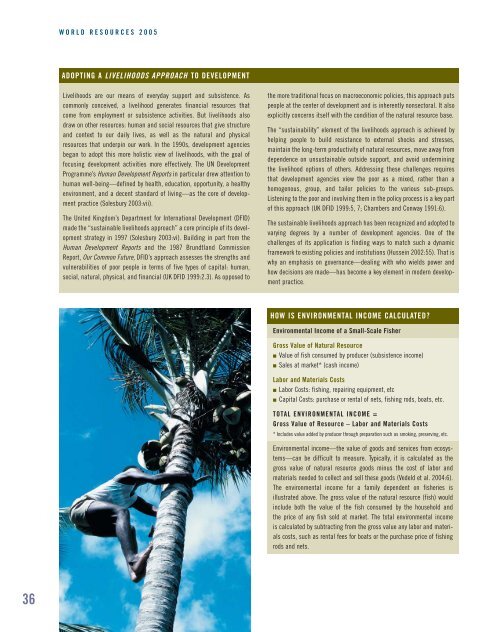jp8589 WRI.qxd - World Resources Institute
jp8589 WRI.qxd - World Resources Institute
jp8589 WRI.qxd - World Resources Institute
Create successful ePaper yourself
Turn your PDF publications into a flip-book with our unique Google optimized e-Paper software.
WORLD RESOURCES 2005<br />
ADOPTING A LIVELIHOODS APPROACH TO DEVELOPMENT<br />
Livelihoods are our means of everyday support and subsistence. As<br />
commonly conceived, a livelihood generates financial resources that<br />
come from employment or subsistence activities. But livelihoods also<br />
draw on other resources: human and social resources that give structure<br />
and context to our daily lives, as well as the natural and physical<br />
resources that underpin our work. In the 1990s, development agencies<br />
began to adopt this more holistic view of livelihoods, with the goal of<br />
focusing development activities more effectively. The UN Development<br />
Programme’s Human Development Reports in particular drew attention to<br />
human well-being—defined by health, education, opportunity, a healthy<br />
environment, and a decent standard of living—as the core of development<br />
practice (Solesbury 2003:vii).<br />
The United Kingdom’s Department for International Development (DFID)<br />
made the “sustainable livelihoods approach” a core principle of its development<br />
strategy in 1997 (Solesbury 2003:vi). Building in part from the<br />
Human Development Reports and the 1987 Brundtland Commission<br />
Report, Our Common Future, DFID’s approach assesses the strengths and<br />
vulnerabilities of poor people in terms of five types of capital: human,<br />
social, natural, physical, and financial (UK DFID 1999:2.3). As opposed to<br />
the more traditional focus on macroeconomic policies, this approach puts<br />
people at the center of development and is inherently nonsectoral. It also<br />
explicitly concerns itself with the condition of the natural resource base.<br />
The “sustainability” element of the livelihoods approach is achieved by<br />
helping people to build resistance to external shocks and stresses,<br />
maintain the long-term productivity of natural resources, move away from<br />
dependence on unsustainable outside support, and avoid undermining<br />
the livelihood options of others. Addressing these challenges requires<br />
that development agencies view the poor as a mixed, rather than a<br />
homogenous, group, and tailor policies to the various sub-groups.<br />
Listening to the poor and involving them in the policy process is a key part<br />
of this approach (UK DFID 1999:5, 7; Chambers and Conway 1991:6).<br />
The sustainable livelihoods approach has been recognized and adopted to<br />
varying degrees by a number of development agencies. One of the<br />
challenges of its application is finding ways to match such a dynamic<br />
framework to existing policies and institutions (Hussein 2002:55). That is<br />
why an emphasis on governance—dealing with who wields power and<br />
how decisions are made—has become a key element in modern development<br />
practice.<br />
HOW IS ENVIRONMENTAL INCOME CALCULATED?<br />
Environmental Income of a Small-Scale Fisher<br />
Gross Value of Natural Resource<br />
■ Value of fish consumed by producer (subsistence income)<br />
■ Sales at market* (cash income)<br />
Labor and Materials Costs<br />
■ Labor Costs: fishing, repairing equipment, etc<br />
■ Capital Costs: purchase or rental of nets, fishing rods, boats, etc.<br />
TOTAL ENVIRONMENTAL INCOME =<br />
Gross Value of Resource – Labor and Materials Costs<br />
* Includes value added by producer through preparation such as smoking, preserving, etc.<br />
Environmental income—the value of goods and services from ecosystems—can<br />
be difficult to measure. Typically, it is calculated as the<br />
gross value of natural resource goods minus the cost of labor and<br />
materials needed to collect and sell these goods (Vedeld et al. 2004:6).<br />
The environmental income for a family dependent on fisheries is<br />
illustrated above. The gross value of the natural resource (fish) would<br />
include both the value of the fish consumed by the household and<br />
the price of any fish sold at market. The total environmental income<br />
is calculated by subtracting from the gross value any labor and materials<br />
costs, such as rental fees for boats or the purchase price of fishing<br />
rods and nets.<br />
36

















